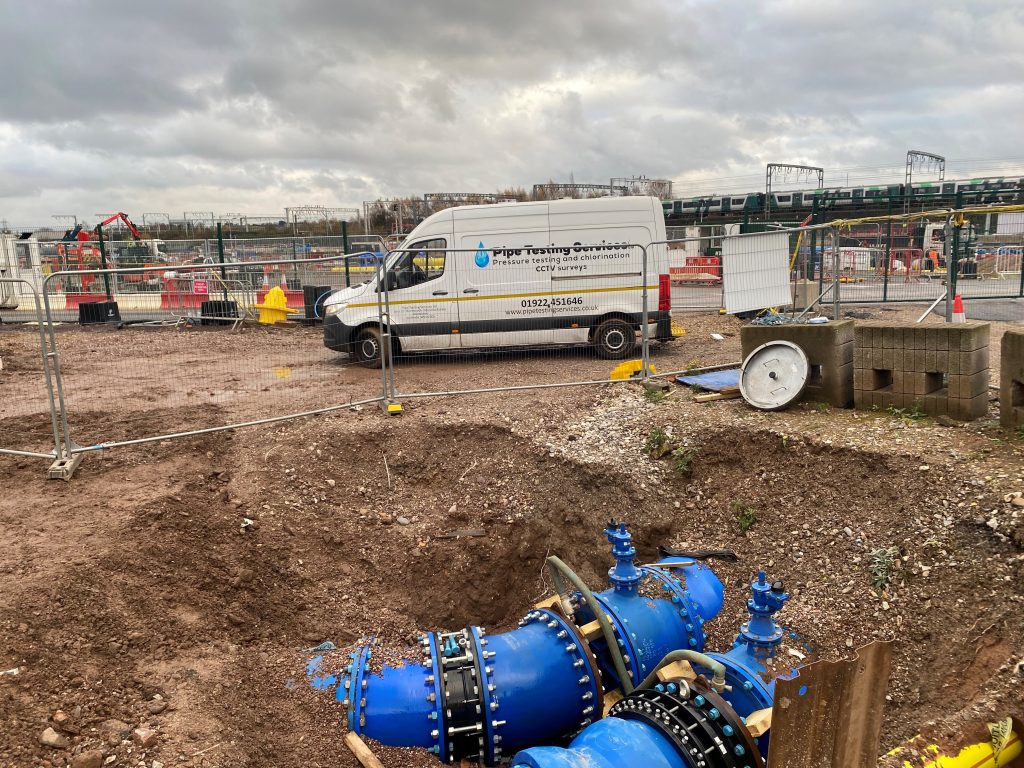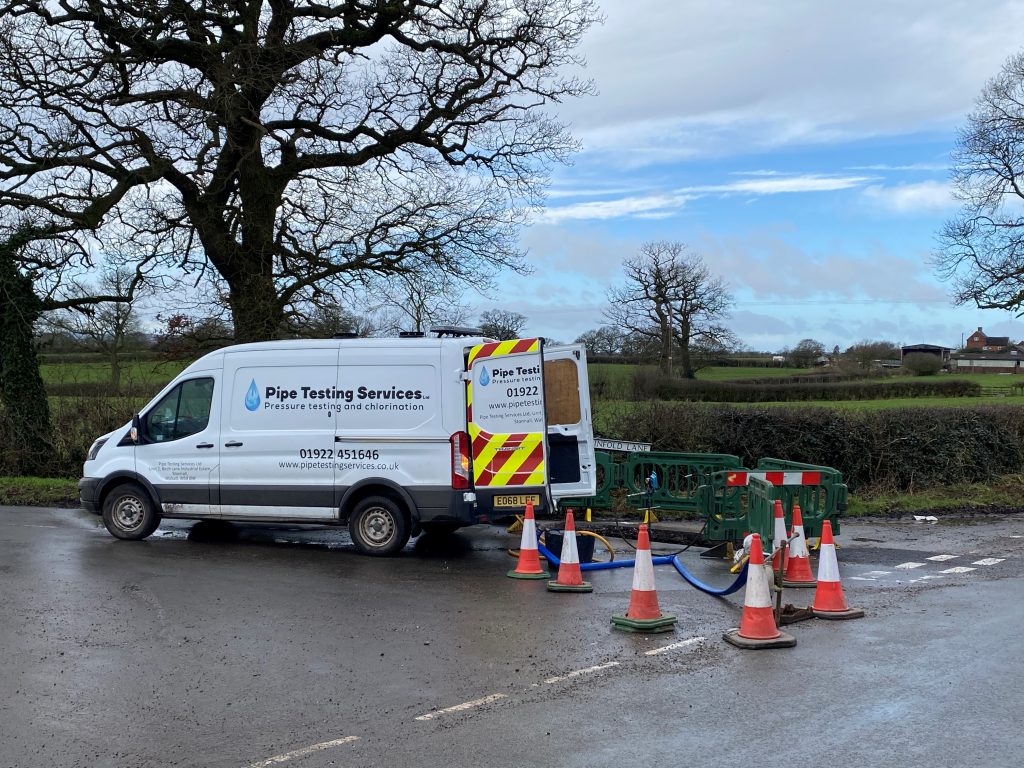Valve to Valve Hydrostatic Testing Procedure
Valve to valve hydrostatic testing is a specialised method of pressure testing pipelines and piping systems.
This approach involves isolating sections of the system between two valves. Isolated segments are subjected to hydrostatic pressure testing individually. The purpose of valve to valve testing is to identify leaks, defects, or weaknesses. Especially in localised areas of the piping network.
Conducting hydrostatic testing on a valve to valve basis offers several advantages. Compared with testing the complete system as a single unit. It allows for focused testing of specific sections, minimising the potential impact of a failure during testing. Additionally, valve to valve testing often requires a smaller volume of test medium, reducing costs and logistical challenges.
At Pipe Testing Services (PTS), we carry out hydrostatic and rising mains pressure testing services regularly for clients nationwide. If you’re looking for a cost-effective testing solution for water infrastructure and pipelines, don’t hesitate to get in touch.
In need of services – take a look here. Alternatively, take a look at our dedicated site for Hydrostatic pressure testing
When to Use Valve to Valve Testing
For our team at PTS, Valve to valve hydrostatic testing is particularly beneficial in the following scenarios:
- Large or Complex Piping Systems - For extensive piping networks with multiple branches, loops, or interconnections. Testing the entire system at once may be impractical or challenging. Valve to valve testing enables a more manageable and targeted approach.
- Systems with Multiple Branches or Loops - Piping systems with numerous branches or loops can benefit from valve to valve testing. Moreover, isolating individual sections can simplify the testing process. Facilitating more accurate identification of potential issues.
- Existing Systems Undergoing Repairs or Modifications - Valve to valve testing allows for specific sections to be evaluated. Specifically when existing piping systems undergo repairs, replacements, or modifications.
Step-by-Step Valve to Valve Testing Procedure
System Preparation
- Isolating the Section: Identify the section of the piping system to be tested and isolate it between two valves by closing off the appropriate isolation valves.
- Installing Temporary Blanks or Blinds: Install temporary blanks or blinds at the valve locations to provide a physical barrier and ensure complete isolation of the test section.
- Providing Connections for Test Equipment: Install the necessary connections, fittings, and adapters to enable the attachment of test equipment, such as pumps, pressure gauges, and vents.
Filling and Venting
- Filling the Isolated Section - Fill the isolated section with the chosen test medium, typically water or another suitable liquid approved for hydrostatic testing.
- Venting Air Pockets - Properly vent the section to remove any trapped air pockets, ensuring that the test medium completely fills the isolated segment.
Filling and Venting
- Increasing Pressure - Connect the pressurization equipment, such as high-pressure pumps or compressors, and gradually increase the pressure within the isolated section to the specified test pressure.
- Monitoring Pressure and Checking for Leaks - Closely monitor the pressure gauges and visually inspect the section for any signs of leaks or pressure drops during the pressurization process.
Hold Period
- Maintaining Test Pressure - Once the desired test pressure is achieved, maintain it within the specified tolerance range for a predetermined hold period, typically ranging from several hours to a full day or more, depending on the specific testing requirements.
- Continuous Monitoring - Throughout the hold period, continuously monitor the pressure gauges and perform visual inspections to detect any pressure changes or visible leaks.
Depressurization and Draining
- Safely Releasing Pressure - After successfully completing the hold period, safely release the pressure from the tested section following proper depressurization procedures.
- Draining the Test Medium - Drain the test medium from the isolated section, preparing it for the next valve to valve section to be tested, if applicable.
Documentation
- Recording Test Data and Results - Thoroughly document all test data, observations, and results for the valve to valve section tested, including pressure readings, hold times, and any deviations or anomalies detected during the testing process.
Testing Requirements and Standards
Valve to valve hydrostatic testing must comply with relevant industry standards and regulations to ensure safety and consistency. Moreover, these standards are very important to us at PTS, and our methods are dictated by them. Let’s take a look at some of the key UK guidelines:
BS 806 and BS 1306 – The British Standards (BS) 806 and 1306 provide comprehensive requirements for design, construction, and operation of ferrous piping systems installations, including hydrostatic testing procedures and acceptance criteria.
BS EN 14161 and BS EN 1594 – These European standards implemented in the UK as British Normative Standards cover pressure testing of liquid petroleum pipelines using water as the test medium.
Pipelines Safety Regulations 1996 (PSR) – The PSR regulations govern the testing and operation of pipelines transporting hazardous materials, including specific requirements for hydrostatic testing.

These standards and regulations define factors such as test pressures, hold durations, test medium selection, and acceptance criteria based on the piping material, design pressure, and intended service.
Safety Considerations
Hydrostatic testing, especially valve to valve testing, involves working with high pressures and potentially hazardous materials. As such, safety must be the top priority throughout the testing process. Here are some critical safety considerations:
High-Pressure Hazards
The pressures involved in hydrostatic testing can be extremely high, posing risks of equipment failure, piping ruptures, and injuries. Strict adherence to safety protocols, proper use of personal protective equipment (PPE), and maintaining safe distances are essential.
Water Discharge and Environmental Concern
The discharge of test medium (water or other fluids) can potentially impact the surrounding environment. Proper containment, treatment, and disposal methods should be implemented to mitigate environmental risks.
Emergency Response Plans
Comprehensive emergency response plans should be in place to address potential incidents, such as leaks, piping failures, or other unforeseen events during testing. These plans should include procedures for isolating affected areas, mitigating risks, and ensuring the safety of personnel and the environment.
Advantages of Valve to Valve Testing
- Localised Testing: Valve to valve testing allows for focused evaluation of specific sections, enabling more efficient identification and isolation of potential issues.
- Reduced Test Medium Volume: By testing smaller isolated sections, the required volume of test medium (e.g., water) is significantly reduced, minimising costs and logistical challenges.
- Minimised Impact of Failure: In the event of a failure during testing, the impact is contained within the isolated section, reducing the potential risks and consequences.
Limitations of Valve to Valve Testing
- Increased Testing Time: Testing each section individually can be more time-consuming compared to testing the complete system at once.
- Need for Temporary Isolation and Connections: Valve to valve testing requires the installation of temporary blanks, blinds, and connections for test equipment, adding complexity and preparation time.
- Potential for Missed Interactions: While effective for localised testing, valve to valve testing may not fully replicate the stress conditions experienced by the complete system during operation, potentially missing interactions between different sections.
Get in Contact with PTS for Expert Hydrostatic Pressure Testing Services
At Pipe Testing Services (PTS), we specialise in providing comprehensive hydrostatic testing services that comply with the highest industry standards and regulations.
Our experienced team, combined with state-of-the-art equipment, ensures the integrity of your piping systems, mitigating potential risks to the environment, public safety, and your assets.
Whether you require valve to valve testing for localized evaluations or complete system testing, we have the expertise to meet your specific project requirements. Our services encompass all aspects of hydrostatic testing, including system preparation, pressurization, monitoring, documentation, and post-testing activities.
If you have any further questions or need assistance with valve to valve hydrostatic testing, complete system testing, or related services like pipeline flushing and dewatering, please don’t hesitate to contact our experts at PTS.
Phone – 01922 451646
Email – enquiries@pipetestingservices.co.uk
Address – Unit 27 Birchbrook Industrial Estate, Shenstone, Lichfield, Staffs, WS14 0DJ

